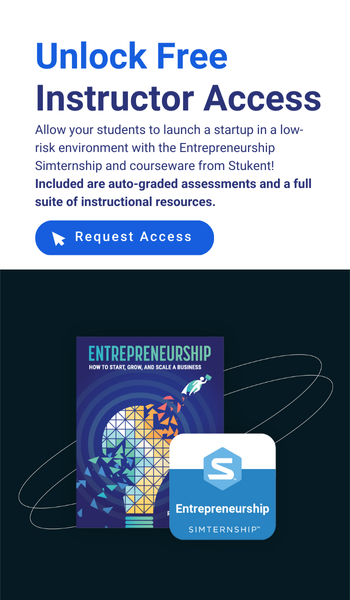Written by Dr. Jen Riley
What is creativity? Is it abstract painting, is it thinking outside of the box, or is it simply challenging the status quo? I’ve always felt creativity has an unreachable air. It seemed to be reserved for artsy types and generally had no place in business outside of the graphic design team. As a professional, I was told that marketing and creative were two different skill sets, and I had to “pick one.”
Needless to say, I did not like that, not one bit. But, recently, I’ve seen more business-centered outlets championing creativity as a necessary skill for business success.
While I’m elated to see this societal shift, it only spurs more questions. I agree that creative thinking and approaches will continue to increase as a significant skill for student and employee success. However, I’m also concerned that most academic programs are not positioned to increase student creativity. Often, we (as professors) provide students with strict instructions, detailed rubrics, and examples of what they should produce that I fear we over-instruct and stifle opportunities for creative thinking.
I began to wonder: Is creativity something you can teach? What would that look like? How could we provide students guardrails but also freedom for individual expression of thought?
But why is creativity important in business? you might ask. According to Forbes, creativity is about “envisioning and implementing novel solutions to challenges.“ Don’t we all want that for our students as they move into professional roles?
Creativity can also look different depending on the person and the situation. Spurred by curiosity, creativity is often simply a perspective varying from the norm. Being creative is not this ominous, unattainable challenge that we sometimes perceive it to be. So, how can we teach creativity? Well, I’m glad you asked! I’ve come up with four ways that business faculty can encourage creativity as a skill for students to embrace.
1. Try New Things
To increase creativity, it’s helpful to step outside of your comfort zone to learn and try new things. As students, learning does not always feel good, and it’s often not apparent to the learner that the increase in knowledge is even happening. When students intentionally try new things and accept that they aren’t immediately going to excel, it helps them grow.
This does not have to be extreme or drastic; it can be small and straightforward. For example, encouraging students to change their work environment can help spur creativity. As their surrounding stimuli change, it allows them to unlock different aspects of their thinking. Inspiration can strike at any moment, including while trying something new.
By partaking in a new activity, exploring a new place, or talking to new people, students can broaden their perspectives and expand their thinking on a topic or situation. That growth then allows them to be more creative as they approach future challenges based on their new experiences.
2. Think Outside the Box
It sounds cliché, but it’s true. The practice of looking at challenges in new ways is a keen strategy to unlock innovation. Encourage students not to go with their first thought to “get the assignment over with,” but to continue searching for other solutions. Unconventional thinking helps students turn unlikely ideas into something wonderful.
For example, food delivery apps were not needed and the business model had not been proven, but when COVID-19 hit, they were a game-changer. Directing students to look at the world without the unspoken rules of “how things are done,” could generate the next big idea.
3. Reevaluate Past Failures
Case studies are not the only way students can learn from others’ experiences. Encourage students to consider their past actions, describe whether they led to success or failure, and evaluate how they would go about these situations differently now.
Learning from other people’s (and your own) mistakes is a valuable tool in life and the classroom. Be sure to emphasize to students that success is not guaranteed, but by reviewing their past choices, their perspective broadens and they can generate new ideas based on how the world, their circumstances, or their personal development has evolved since the incident in question.
4. Use AI to Get Started or Past a Slump
I know it seems taboo, and a lot of academics are against artificial intelligence (AI), but I doubt it’s going anywhere. We need to teach students how to harness its power for good rather than ignoring its existence and engaging in blanket mistrust. While some research says AI cannot create, it can help stretch someone’s limited perspective that is solely based on their lived experiences.
Asking AI to generate ideas for a challenge or leveraging it when you feel a lack of ideas can help keep the ball rolling. The key here is to (1) instruct students to cite their usage of AI tools and (2) not take its output at surface value. Students should always read and evaluate what AI generates. Instruct them to conduct additional research to verify “facts,“ or assess the output in relation to what the initial goal was. Remind students to never, ever, use what AI gives word for word but instead develop critical thinking by evaluating what it generates.
Let AI be inspiration. I recommend having students do the first draft, AI do the second, and the student combine the two for a third. It’s not a “sexy” process and it takes a little longer, but the final product is often stronger.
Creative Class Activities
For students entering the job market, their ability to be creative can bring immense value to an organization. However, challenging the status quo requires a delicate balance. Many people get into a rut of doing things a certain way because that’s how they’ve always been done. I’d encourage students to embrace creativity but vet their ideas and support their perspective with numbers and facts whenever possible. It’s our job as faculty to help uplift creativity and accept unconventional thinking, but also help students understand how to present that information.
For activities that help students step outside their comfort zones, see these free exercises: Interactive Improv Games to Teach Soft Skills.
Class activities that allow students to “get it wrong“ help build a comfortable environment where learning can truly take place. Even “wrong“ answers can contribute to creativity by prompting a discussion of that perspective. Creativity is no longer a luxury, but a necessity. I hope implementing these four areas can help you encourage creativity among your students.
Dr. Jen Riley is an award-winning Marketing & Professional Sales Researcher examining the cross section of technology and professional selling and salesperson value co-creation. She teaches marketing at Vanderbilt University.







